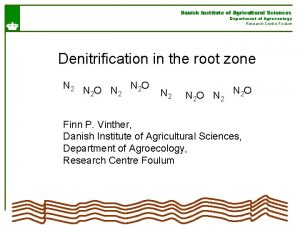Danish Institute of Agricultural Sciences Extraction and Quantification

- Slides: 1

Danish Institute of Agricultural Sciences Extraction and Quantification of Chlorophyll and Carotenoid Pigments in Processed Green Peas (Pisum sativum L. ) Merete Edelenbos*, Lars P. Christensen and Kai Grevsen Department of Horticulture, Danish Institute of Agricultural Sciences, Research Centre Aarslev, Kirstinebjergvej 10, DK-5792 Aarslev. E-mail: merete. edelenbos@agrsci. dk Introduction Green peas (Pisum sativum L. convar. medullare Alef. ) for deep freezing is an important vegetable crop in Denmark. The market quality of this vegetable depends on factors such as flavor, texture, size and colour (1); parameters that are influenced by genotype, growing conditions, maturity at harvest, processing conditions and handling by consumers prior to consumption (2, 3). The work reported here is part of an extensive research program focusing on pea quality aspects in the total chain from plant breeding to consumption (1). The part of the program focusing on pea colour and pigment composition of pea cultivars included development of a method for the extraction and quantification of chlorophyll and carotenoid pigments in processed green pea cultivars. Aim The objective of the present study was to develop an analytical method for the extraction and quantification of chlorophyll and carotenoid pigments in processed green peas. Materials and methods Extraction of pigments. Pea samples (10 g) were homogenized with 5 g water at room temp. A 10 g sub-sample was suspended in 10 ml cold 100% acetone, homogenized, centrifuged and the resulting supernatant saved. The sample was re-extracted 3 times as described above, which ensured > 98% extraction of carotenoids and chlorophylls. The supernatants were pooled, diluted to 50 ml with 100% acetone and filtered directly into a 4 ml vial and analysed by analytical HPLC. The above method was developed after a series of initial experiments where e. g. the efficiency of extraction with 100% acetone with or without re-extractions was studied (Table 1). Pigment stability during processing. For studies of pigment stability raw peas (cv. Bella) were divided into 3 sub-samples and each sub-sample then divided into a sample for direct extraction (raw sample) and a sample for cooking and then extraction (cooked sample). Peas were cooked for 3 min in boiling water, drained, cooled (25 °C) and then extracted. Separation of pigments by reversed-phase HPLC. A Shimadzu HPLC system equipped with a SPD 10 AV UV-vis detector was used. Separations were performed on a Li. Chrospher 100 RP-18 column. Mobile phases consisted of solvent A (80% Me. OH– 20% H 2 O) and solvent B (100% Et. OAc). Separations were performed at 30 °C by the following solvent gradient: 0 min 20% B, 2. 5 min 22. 5% B, 20– 22. 5 min 50% B, 24– 26 min 80% B, 31– 34 min 100% B, 42– 47 min 20% B. Flow rate: 1 ml/min. Injection volume: 25 l. Detektion: 440 nm. Identification and quantification of pigments. Identification was based on chromatographic behavior on analytical HPLC, UV-spectra and their reaction with ethanolic 0. 1 M HCl after isolation by flash CC and prep. HPLC (4). Acid catalyzes the specific isomerization of 5, 6 epoxides to 5, 8 -furanoid oxides, resulting in a hypsochromic shift of approx. 20 nm for mono-epoxides and 40 nm for di-epoxides (4, 5). The carotenoids and chlorophylls were quantified using an external calibration method for (all-E)-lutein, (all-E)- -carotene, chlorophyll a and b (5). Results and discussion Extraction and quantification. A total of 17 pigments were identified and quantified in green peas (Table 1) including 8 xanthophylls, 4 chlorophyll b related compounds, 4 chlorophyll a related compounds and (all-E)- -carotene. The efficiency of different extraction procedures using 100% acetone showed that initial extraction followed by three re-extractions without holding time in between resulted in a significant higher chlorophyll and carotenoid concentration than no re-extraction and 30 or 60 min holding time (Table 1). Table 1. The Pigment Concentration in Processed Peas (cv. Tristar) Using Different Extraction Techniques with 100% Acetonea. Figure 1. The concentration of carotenoids and chlorophylls in raw and cooked peas of cv. Bella. Mean of three extractions. Pigments followed by different letters are significantly different at P = 0. 05 by Duncan’s multiple range test. a. Mean of triplicate analysis per method. Numbers within a row followed by different letters are significantly different at P = 0. 05 by Duncan’s multiple range test. b. Approx. 20% of the content was neochrome. Pigment Stability during processing. The (all-E)-lutein concentration increased significantly with cooking from 1300 mg/100 fresh weight to 1800 mg/100 fresh weight (Fig. 1). However, this increase was not caused by loss of water during cooking. The water content was 78. 0% in raw and 77. 7% in cooked peas. Cooking had no significant effect on the total chlorophyll concentration but the chlorophyll a and b concentration decreased and the chlorophyll a’ and b’ and pheophytin a and b concentration increased, respectively (Figure 1). References 1. Juhl HJ, Bech AC, Kristensen K, Poulsen CS, Hansen M (1998) Consumer involvement and evaluation of green peas. J Sensory Studies 13: 1– 11. 2. Ottosson L (1958) Growth and Maturity of Peas for Canning and Freezing. Almqvist & Wiksells Boktryckeri AB: Uppsala, 112 pp. 3. Kidmose U, Grevsen K (1992) Quality of vining pea varieties for deep freezing. Danish J Plant Soil Sci 96: 353– 360. 4. Khachik F, Beecher GR, Whittaker NF (1986) Separation, identification, and quantification of the major carotenoid and chlorophyll constituents in extracts of several green vegetables by liquid chromatography. J Agic Food Chem 34: 603– 616. 5. Edelenbos M, Christensen LP, Grevsen K (2001) HPLC determination of chlorophyll and carotenoid pigments in processed green pea cultivars (Pisum sativum L. ). J Agric Food Chem 49: 4768– 4774.

